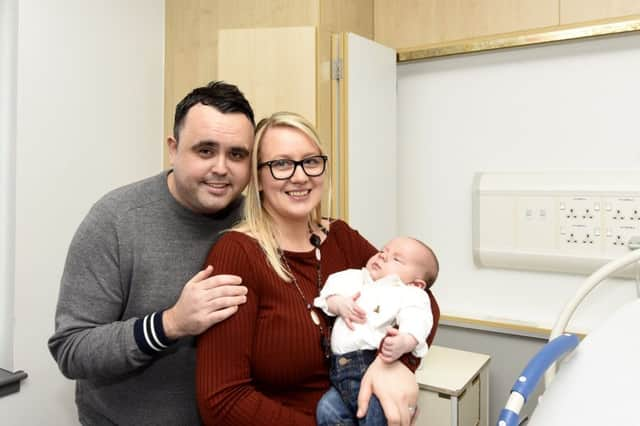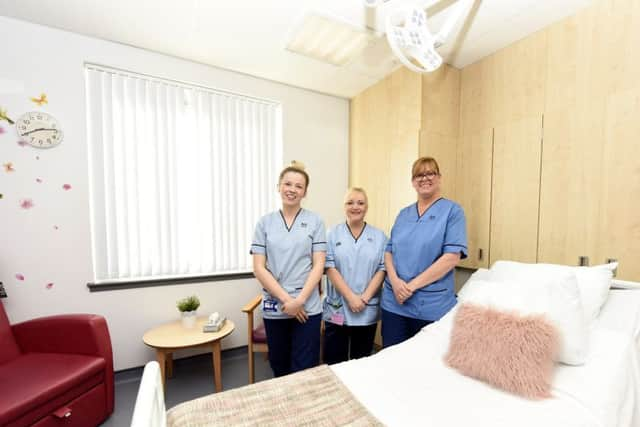Why Fife’s maternity service has a strong homely feel to it


From opening one of the country’s first midwifery led units in 1993 – initially when it was still at Forth Park – which runs alongside the consultant service, to offering the most up-to-date in foetal heart monitoring, it has always been among the first to adopt the latest best practice models.
And it is continuing to do so with a range of new initiatives designed to fill in gaps in the existing service and expand and enhance its overall ante and neo natal care pathways.
Advertisement
Hide AdAdvertisement
Hide AdAnne McKinnon, quality improvement midwife with NHS Fife, said: “We have a lot of new pathways which are aimed at improving our service, from a practice education midwife whose job is specifically about improving education in paediatric services to infant feeding support services, to improving mental health in mothers and making the process better for mothers whose labour is induced.


“For women who may have more complications and require more care like having a caesarian section or being induced we have redesigned our services to keep them more family friendly, keeping partners with them at all times which has proved of great benefit.”
One of the main additions to the service is a new induction suite where women who have to have labour induced can spend time in a controlled but relaxed environment which will be beneficial to both mother and baby.
You may also be interested in:
It was introduced at Victoria Hospital about six months ago and around 80 women a month have labour induced, with a team of four experienced midwives and four auxilliaries in charge.
Advertisement
Hide AdAdvertisement
Hide AdYvonne Hendrie, senior midwife, told the Press: “We developed the concept because we felt that there was a gap in the service.
“We have four rooms where women can spend time before the birth in a relaxed and homely area with their partners by their side and they can be here from just a few hours or up to a couple of days.
“Partners are actively encouraged to stay and there are beds for them.”
Yvonne explained that the majority of women are induced if they go over the 41 week gestation period, while for others it may be for medical reasons.
Advertisement
Hide AdAdvertisement
Hide Ad“If they are in here when they are induced it makes for a much smoother process for them.
“They will usually see the same midwives during their time here and most women have told us that they enjoy the chance for a bit of peace and quiet before their delivery.
“We induce them slowly to immitate natural labour and when their waters break they go on to either the midwife led unit if they are low risk or on to the antenatal ward. We have been having really good results and the feedback has been very positive.”
Mhairi Macallan is a staff midwife with the Enhanced Recovery for Obstetric Surgery in Scotland (EROSS), a nationwide programme which is being rolled out across the country to help women who have an elective C-section to recover more quickly.
Advertisement
Hide AdAdvertisement
Hide AdShe started her new role last year, and says the results have been really positive.
“It starts out with a lot of ante natal education for women who are planning to have a caesarian section to deliver their babies, so that they know what to expect.
“If they know what is going to happen they will feel more prepared and be more relaxed when the time comes.
“We have classes every Friday in the hospital for the parents and they are told about this in the clinics. Most come about a week before their date and we talk to them about preparation for surgery and what to expect as well as what will happen afterwards to help the mums to recover better.
Advertisement
Hide AdAdvertisement
Hide Ad“This includes things like getting them back on their feet earlier if they are ready for it and eating and drinking. If they are ready then they and baby can be discharged the following day, whereas before it was about four days.
“This is a pathway for those who have elective caesarians, but with emergency ones we try to follow the same procedures afterwards.
“The feedback from women who may have had an emergency section first time around and had an elective one next time is that they feel they are back to normal much quicker, which is much better both for them and for their families.”
Laura Clarke (30) and her husband Jordan had nothing but praise for the staff and the care they received when Laura was taken in to be induced at Victoria Hospital at the end of December last year.
Advertisement
Hide AdAdvertisement
Hide AdThey spent three days in the induction suite before baby Logan was eventually delivered by C-section on New Year’s Day.
Laura said: “The staff were absolutely brilliant and the induction suite was great – it was like having our own little flat and Jordan was able to stay with me the whole time.
“It made me feel much more relaxed and I think it’s a great facility. It was so well run I couldn’t believe it was just introduced in October.”
Laura also had the benefit of the enhanced recovery programme after her section.
Advertisement
Hide AdAdvertisement
Hide Ad“It was really good and I felt I recovered well. I hope it continues to help other people going through the same thing,” she added.
The couple returned to the induction suite this week to present radios and infusers to staff, bought with money raised through a Burns’ Supper held by the Lodge Wemyss 777, of which Jordan is a member.